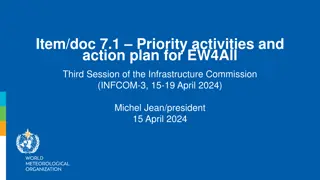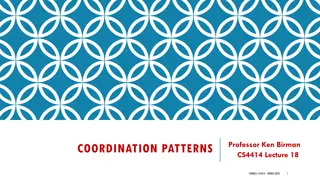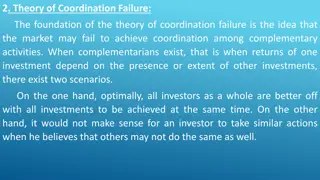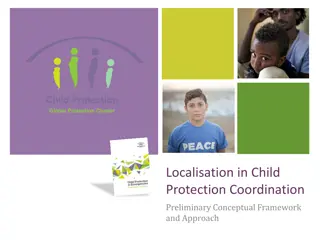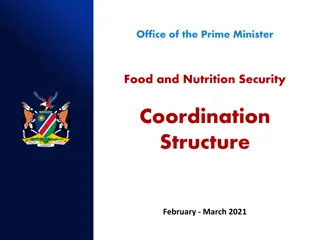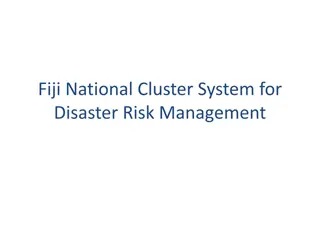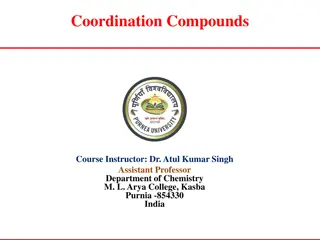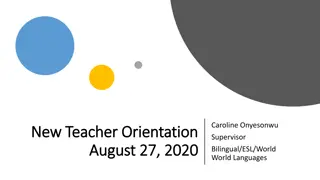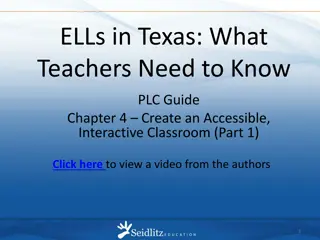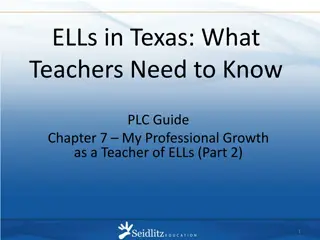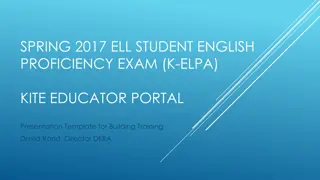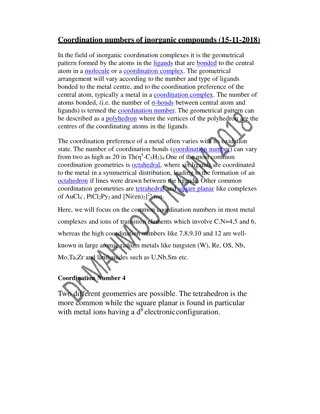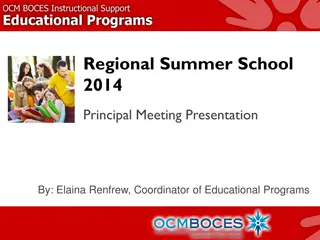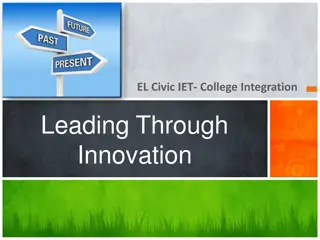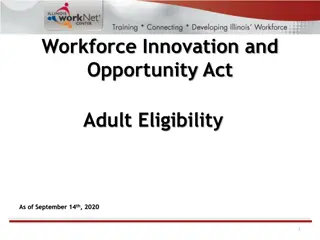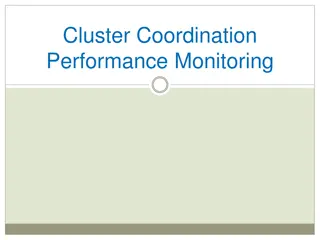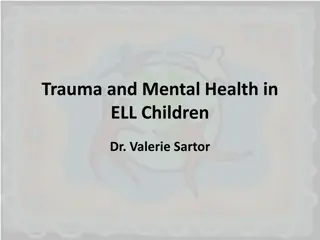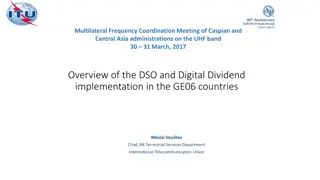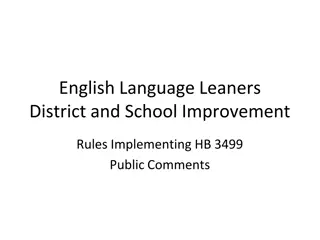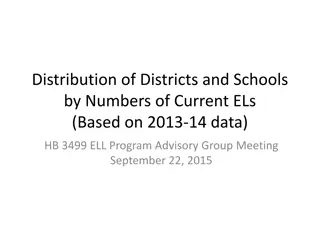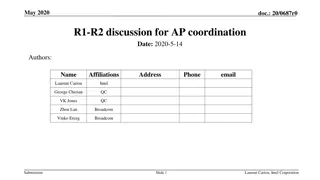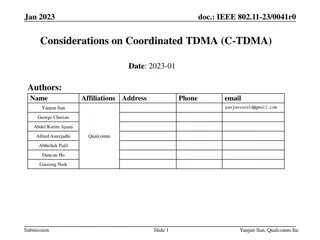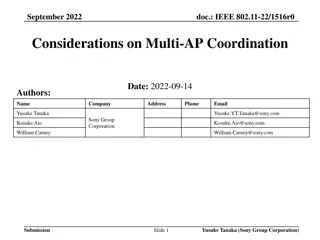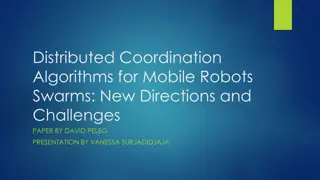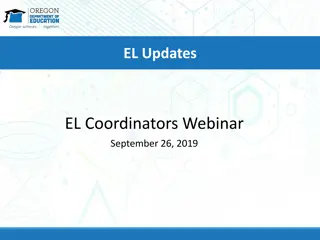CHILD PROTECTION COORDINATION IN MIXED SETTINGS SHARING GOOD PRACTICES
Explore the effective coordination mechanisms and best practices for child protection in mixed settings involving refugees, internally displaced populations, and other affected groups. Topics include similarities, differences, system strengthening, rights-based approaches, coordination responsibilit
2 views • 25 slides
Grade 10-11 Course Planning and Graduation Requirements Overview
Explore the essential aspects of grade 10-11 course planning, graduation requirements, and assessments for high school students. Learn about the importance of fulfilling both graduation and university admission requirements, including the specifics of the Dogwood Diploma requirements, credit distrib
6 views • 37 slides
Introduction to Co-ordination Chemistry: Fundamentals and Applications
Explore the fascinating field of coordination chemistry, delving into the complexity of compounds and the coordination bonds that govern their structures. Discover the history, key concepts, and applications of coordination chemistry through a detailed examination of coordination compounds, bonding
13 views • 73 slides
Enhancing R-TWT with Multi-AP Coordination in IEEE 802.11 Networks
Delve into the world of IEEE 802.11 wireless networks as this document explores solutions for multi-AP coordination for R-TWT, focusing on improving tail latency, jitter, and medium protection. Enhancements in R-TWT operation, coordination scenarios, and solutions for multi-AP deployments are discus
1 views • 12 slides
MSCS Literacy Commitment
Tennessee state law mandates that starting from the 2022-2023 school year, 3rd-grade students must demonstrate proficiency in English Language Arts (ELA) to be promoted to the next grade level. Proficiency is determined by achieving a performance level rating of "on track" or "mastered" on the ELA s
0 views • 13 slides
Priority Activities and Action Plan for EW4All Infrastructure Commission: INFCOM-3 Session
The document outlines the priority activities and action plan for the Third Session of the Infrastructure Commission (INFCOM-3) within the Early Warnings for All initiative. It includes background decisions, a draft list of priority activities, and an action plan for contributions to the initiative.
5 views • 10 slides
COORDINATION PATTERNS
Coordination patterns play a crucial role in designing concurrent code, ensuring smooth operation and efficient performance. They help in managing interactions between threads or processes, preventing malfunctions and performance drops. Examples like producer-consumer pattern and bounded buffers ill
1 views • 69 slides
Understanding the Theory of Coordination Failure in Markets
The theory of coordination failure explores how markets may struggle to achieve coordination among complementary activities, leading to suboptimal outcomes. It highlights scenarios where investors' actions depend on each other, emphasizing the role of government intervention to solve coordination is
2 views • 14 slides
Localisation in Child Protection Coordination: A Conceptual Framework
This presentation explores the preliminary conceptual framework and approach for localisation in child protection coordination. It delves into the roles of local actors, coordination systems, governance, decision-making, partnerships, and funding in promoting localisation efforts. The importance of
0 views • 22 slides
Improving Food and Nutrition Security Coordination Structure in Namibia
The document outlines the establishment, evolution, and recent developments in the coordination structure for food and nutrition security in Namibia, with a focus on government commitment, stakeholder involvement, and coordination mechanisms. It highlights the transition from dormant entities to the
0 views • 22 slides
Fiji National Cluster System for Disaster Risk Management
The Fiji National Cluster System for Disaster Risk Management emphasizes the importance of coordination in emergencies, aiming to reduce gaps and overlaps through a coherent, complementary approach. Global Cluster coordination systems have been adopted to enhance collaboration among various humanita
1 views • 22 slides
Understanding Coordination Compounds and Ligands in Chemistry
Coordination compounds involve ligands that donate electron pairs to central metal ions. Ligands can be categorized based on the number of donor atoms they contain, such as mono-, bi-, tri-, tetra-, penta-, and hexadentate ligands. Each type of ligand has the ability to form bonds with the central m
2 views • 15 slides
New Teacher Orientation - Supporting Multicultural Education and English Language Learners
The new teacher orientation session led by Supervisor Caroline Onyesonwu on August 27, 2020, focused on supporting multicultural education and English Language Learners (ELLs). The agenda included activities like exploring one's multicultural self, discussing ELL student placement and language profi
1 views • 18 slides
Enhancing ELL Instruction: Strategies for an Accessible Classroom
Explore practical strategies for creating an interactive and accessible classroom environment for English Language Learners (ELLs) in Texas. This guide covers key topics such as lowering the affective filter, providing comprehensible input, and making instruction more compelling. Engage in discussio
0 views • 7 slides
ESOL Department Meeting Agenda and Accommodations Overview
Explore the agenda for the Bilingual/ESOL Department meeting scheduled on Tuesday, March 6, 2018. The meeting will focus on compliance reminders, policy discussions, and strategies for ACCESS for ELLs accommodations. Learn about ELLevation tools, testing accommodations for ELLs, instructional practi
0 views • 42 slides
Sub-national Nutrition Cluster Coordination Training Workshop
Welcome to the Sub-national Nutrition Cluster Coordination Training Workshop aimed at sharing key concepts, tools, and approaches for effective coordination of nutrition in emergencies. This training prepares participants for working in Nutrition Cluster/Sector Coordination, promoting dialogue and s
1 views • 10 slides
Professional Growth Strategies for Teachers of ELLs in Texas
Explore strategies for professional growth in teaching English Language Learners (ELLs) in Texas, including reviewing educator standards, attending professional development opportunities, and assessing expertise levels to progress from inexperienced to expert. Develop a Personal Professional Plan to
0 views • 7 slides
Enhancing Care Coordination Through Agreements
Effective care coordination is crucial for ensuring quality referrals and improving patient outcomes. Develop a Care Coordination Agreement to streamline the referral process, reduce waste, and enhance cost-effectiveness in healthcare delivery. This agreement serves as a roadmap for standardizing co
0 views • 49 slides
KITE Educator Portal Training Guide for K-ELPA Coordinators
Access the KITE Educator Portal for the SPRING 2017 ELL Student English Proficiency Exam training. Learn how to log in, manage user roles, navigate the portal, and access important information for building test coordinators. Follow the steps outlined to ensure smooth coordination and efficient utili
0 views • 15 slides
Coordination Numbers in Inorganic Compounds: Geometries and Structures
In inorganic coordination complexes, the coordination number refers to the number of atoms bonded to the central atom. Common geometries include octahedral, tetrahedral, and square planar, depending on the type and number of ligands. Transition metal complexes exhibit different coordination numbers
2 views • 8 slides
Understanding Coordination Chemistry: Structures, Isomers, and Naming
Exploring coordination chemistry involves understanding structures, isomers, naming conventions, and common coordination numbers, all essential in studying coordination compounds. Coordination compounds consist of central metals, ligands, and charge balancing ions. Naming involves listing cations, l
0 views • 46 slides
OCM BOCES Regional Summer School 2014 Principal Meeting Presentation
OCM BOCES Regional Summer School 2014 aims to provide credit recovery opportunities and initial credit options aligned with state standards. Program components under review include grading policy, attendance policy, course offerings, testing center, ELL program, and more. Specific proposals include
0 views • 13 slides
Innovative Integration Strategies for Enhancing College Enrollment and Success
This collection of images and descriptions outlines a comprehensive approach to address challenges faced by low-skilled and English language learner (ELL) students in increasing college enrollment and success rates. Strategies include targeted remediation support, collaboration with testing centers,
0 views • 16 slides
Understanding Adult Eligibility Guidelines under the Workforce Innovation and Opportunity Act (WIOA)
Explore the key aspects of Adult Eligibility under the Workforce Innovation and Opportunity Act (WIOA) including requirements such as age, citizenship, and Selective Service registration. Learn about changes from WIA to WIOA, priorities for low-income individuals, Basic Skills Deficient (BSD) and En
0 views • 25 slides
Understanding Cluster Coordination Performance Monitoring (CCPM)
The Cluster Coordination Performance Monitoring (CCPM) is a self-assessment tool that helps evaluate cluster performance against core functions and Accountability to Affected Populations. It aims to improve coordination and accountability within clusters, developed by the IASC Sub-Working Group. Mon
0 views • 16 slides
Inclusive Practices in Red Clay School District Overview
The Red Clay School District strives for inclusive practices where every student has equal access to quality education. The community aims for college and career readiness, emphasizing shared belief and support for all learners. The district focuses on building capacity through professional developm
0 views • 36 slides
Understanding Coordination Complexes and Transition Metals
Today's lecture covers transition elements, coordination complexes, ligand types, geometries, naming, isomers, and bonding in coordination complexes. Transition metals form coordination complexes with metal ions, ligands, and counter ions. The types of ligands include monodentate and bidentate ligan
0 views • 24 slides
Refugee Trauma and Mental Health: Understanding and Support
Explore the impact of trauma on ELL children's mental health, effective school interventions for refugees, definitions of refugee status, and the diverse origins of refugees. Learn how schools can foster resilience in war-exposed youth and support individuals as "persons of concern." Delve into spec
0 views • 37 slides
Overview of Multilateral Frequency Coordination Meeting for Digital Dividend Implementation
The Multilateral Frequency Coordination Meeting discussed progress in implementing digital switchover and digital dividend in the GE06 countries. It highlighted the allocation of spectrum for mobile services and the importance of coordinated implementation. Various coordination groups in Region 1 wo
0 views • 14 slides
Oregon HB 3499 Implementation Public Comments
Public comments provide feedback on the implementation of HB 3499 in Oregon, focusing on the rules and improvements needed for English Language Learners (ELL) at the district and school levels. Suggestions include more details with flexibility, accountability for ELL improvement, addressing concerns
0 views • 11 slides
Analysis of EL Numbers in Oregon Schools and Districts
This analysis, presented during the HB 3499 ELL Program Advisory Group Meeting, highlights the distribution of Oregon districts and schools based on the number of current English Learners (ELs). It emphasizes the importance of considering EL numbers in identifying low-performing institutions and dis
0 views • 4 slides
Challenges in Nevada's Education System: Funding, Outdated Formula, and Unique Issues
Nevada faces significant challenges in its education system, with low rankings in education and education funding. The state struggles with outdated funding formulas, inadequate teacher salaries, large class sizes, and regressive funding distribution. These issues lead to overcrowded classrooms, cut
0 views • 19 slides
Enhancing Healthcare Emergency Preparedness and Response in Wisconsin
The Wisconsin Hospital Emergency Preparedness Program (WHEPP) focuses on supporting hospitals in planning and responding to mass casualty incidents and pandemics. It emphasizes the importance of healthcare coalitions, tier coordination, and disaster medical coordination centers. The program, funded
0 views • 30 slides
Proposal for Release 1/R2 Feature Split in Wireless AP Coordination
The proposal suggests modifying the split between Release 1 and Release 2 features for wireless AP coordination in order to address the lack of consensus on the low complexity AP coordination feature. It aims to enhance clarity and efficiency in the development process while maintaining the value of
0 views • 7 slides
Enhancing AP Coordination for Improved Wireless Network Performance
This document discusses considerations for Coordinated TDMA (C-TDMA) in IEEE 802.11 networks to address issues of limited coordination among Access Points (APs). The objective is to enhance coordination among APs to improve network reliability in terms of latency, throughput, and fairness. Design pr
0 views • 14 slides
IEEE 802.11-22/1516r0 AP Coordination Considerations
Review of discussions on AP coordination in WNG sessions and EHT SG/TGbe meetings, proposing advancements for future WLAN technology. Emphasis on the importance of prioritizing AP coordination to address various WLAN objectives effectively. Details on AP coordination subtypes and their impact on rel
0 views • 11 slides
Distributed Coordination Algorithms for Robotic Swarms: Challenges and Innovations
Explore the world of robotic swarms through the lens of distributed coordination algorithms. Discover various coordination tasks, synchronization models, and algorithm results, alongside the evolution of robot models for enhanced efficiency. Delve into coordinated movement, flocking behaviors, and t
0 views • 10 slides
Important Updates and Events in English Language Learning (ELL) Coordination
Stay informed on upcoming regional trainings, technical assistance opportunities, budget narratives, and key events in the English Language Learning (ELL) field. Discover resources, dates to mark your calendar, and contact information for assistance on Oregon statutes, ESSA, Title III, and more.
0 views • 9 slides
Enhancing Care Coordination in the Medical Neighborhood
This content emphasizes the importance of ensuring high-value care coordination through effective referral processes and close-loop tracking in the medical neighborhood. It discusses key action steps, such as developing care coordination agreements and providing a high-value referral response. Furth
0 views • 26 slides
Submarine Cable Resiliency Update and Recommendations
Working Group 4A provides updates on the status of submarine cable resiliency, highlighting the risks to infrastructure due to lack of coordination across agencies and clustering of cable routes. The group aims to enhance regulatory coordination and promote geographic diversity to ensure network res
0 views • 7 slides





